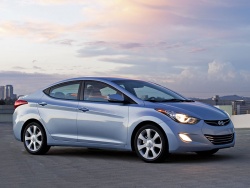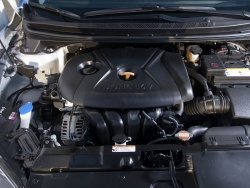 2011 Hyundai Elantra. Click image to enlarge |
By Jim Kerr
Hyundai has set a goal, one that is achievable: they will have their vehicles meet a Corporate Average Fuel Economy (CAFÉ) rating of 50 miles per gallon U.S. (4.7 L/100 km) by 2025. Why not now you may ask?
Well, some of the technology needed to achieve this is still in the development stage. However, Hyundai is now in the process of introducing a new series of engines that will form the basis for these new technologies. One of these will be found in the new 2011 Elantra and it is appropriately called the NU 1.8-litre.
Before we look at some of the technology in the NU 1.8 and others, let’s go back to the matter of Corporate Average Fuel Economy (CAFÉ). In 1977, the Environmental Protection Agency (EPA) introduced window stickers on vehicles showing the fuel economy of the vehicle. The rating was based on the same test procedures as the CAFÉ standards.
After some years, the EPA determined that actual fuel economy and the CAFÉ ratings were not the same, so they revised the window stickers by adjusting City economy down by 10 per cent and highway economy down by 22 per cent. In 2008, further adjustments were made so that actual fuel economy was closer to the numbers on the window sticker.
 2011 Hyundai Elantra. Click image to enlarge |
Now for 2011, a new five-cycle test has been introduced that incorporates cold starts and air conditioning use. The effect of this is that EPA window sticker fuel economy is about 24 per cent lower than the CAFÉ rating, so in real terms a CAFÉ rating of 50 mpg is an EPA rating of 37 mpg. Convert the CAFÉ rating to Imperial gallons and it is 60 mpg here, or 4.7 L/100 km. Confused? Blame it on “new math.”
Leaving aside the confusion of different fuel economy ratings, the reality is that fuel economy is improving and Hyundai has many technologies in the works to achieve “50 mpg” CAFÉ. The NU 1.8-litre engine replaces the 2.0-litre engine in last year’s Elantra. It puts out seven per cent more power and achieves 7.4 per cent better fuel economy (18 per cent overall when other vehicle improvements are included). Some of the features that enable this gain are double overhead camshafts with variable valve timing, reduced engine friction with roller valve mechanisms, electronic throttle-body control, a two-stage variable path intake system, an aluminum engine block that reduces weight by 74 pounds and a crankshaft that is offset in the block by 11 mm. (Offsetting the crankshaft to one side of the cylinder allows the connecting rod to have a straighter push downward during the power stroke. This is provides a more efficient power stroke with less sideways force on the piston, which helps reduce drag.)
The 2011 Sonata uses the new THETA II Gasoline Direct Injection (GDI) 2.4-litre engine or the 2.0-litre Turbocharged GDI engine. Look to see more turbocharged engines in the future, as their smaller displacement improves economy, yet yields the power of a bigger engine. The turbo on this engine has a twin scroll exhaust turbine for instant boost that is cast as part of the exhaust manifold to maximize efficiency. Cylinder bores are an “aluminum thermal sprayed counter spiny liner” that bond to the block for better heat dissipation, less cylinder distortion and better control of liner thickness.
Vehicles in the near future will use six- to 10-speed automatic transmissions, auto-stop engine cycles at stop lights, regenerative braking, variable valve lift, variable compression ratios, exhaust heat recovery for quick engine warm up, air conditioning efficiency improvements, solar cells and in the more distant future, controlled auto ignition (diesel cycle gasoline engines), electro-mechanical valves and exhaust heat to generate electricity – more on this in later columns.
By 2020, Hyundai research shows that about 77 per cent of vehicles will still use the internal combustion engine. Hybrids, alternate fuels, plug-in electric vehicles and fuel cell power will make up the rest, but we will continue to use the internal combustion engine for a long time. This engine concept predates the invention of the automobile by centuries. Even with this long history, it is still undergoing some amazing improvements. Who knows what the future may bring? Hyundai thinks they know, and they are working diligently on this at research centres around the world.







 Follow Autos on Twitter
Follow Autos on Twitter



